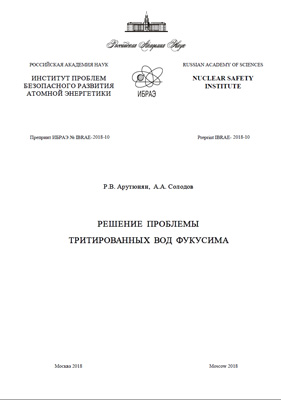| Ðóññêèé / English |
|

|
NUCLEAR SAFETY INSTITUTE OF THE
RUSSIAN ACADEMY OF SCIENCES
|
THE SOLUTION OF THE FUKUSHIMA TRITIATED WATERS PROBLEM (PREPRINT ¹ IBRAE–2018-10)
 Publish year: 2018 Pages: 17 | PUBLISHER: ÈÁÐÀÝ ÐÀÍ Preprint IBRAE-2018-10 Arutunyan R.V., Solodov A.A. The purpose of the paper is description and analisys of simplified technology of the disposal of ~106 tons of disaster waters now stored at Fukushima site. The starting “head” operation is distillation of the waters discussed. This operation separates and sends tritium and the rest of radionuclides to the two distinct products: first — 106 tons of the “target” distillate, contaning tritium and only tritium, and second – relatively compact “waste”, that is consentrated chloride brines, accumulating the total of nonvolatile radionuclides. As the first choice of final operation, the tritiated distillate may be pumped at land into the apropriate underground structures (so-called collectors) to conserve tritium here for some 100—200 years. The second choice is to pump tritiated distilate to the deep ocean waters at the place remote of ocean currents and of tropical cyclons pools. The relatively compacte waste (cloride brines) is to be provisionally stored at Fukushima site. The brines may be treated at the place and preparated for long-time storage or removed to the radiochemical plants for the final utilization. Bibliographical reference R.V. Arutunyan, A.A. Solodov. The solution of the Fukushima tritiated waters problem / Preprint ¹ IBRAE–2018-10. Moscow: Nuclear Safety Institute of the Russian Academy of Sciences (IBRAE RAN), 2018. – 17 p. – Refs.: 18 items. © Nuclear Safety Institute, 2018 |
 |
IBRAE RAN © 2013-2025 | Site map | Feedback |